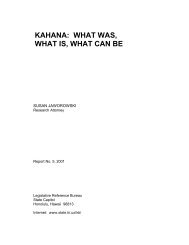long-term care - Legislative Reference Bureau
long-term care - Legislative Reference Bureau
long-term care - Legislative Reference Bureau
Create successful ePaper yourself
Turn your PDF publications into a flip-book with our unique Google optimized e-Paper software.
LONG-TERM CARE SERVICES<br />
6. Home health services: licensed home health <strong>care</strong> authorized by physician to<br />
restore/maintain health and minimize effects of illness or disability which<br />
may include nursing, various therapies, physician services, social work, and<br />
counseling. May be supplemented by personal <strong>care</strong> and homemaker services<br />
or be substituted for by the latter two.<br />
7. Homemaker services: (also known as chore services) are non-medical. Unlike<br />
personal <strong>care</strong> services, they are limited to services to enhance the physical<br />
environment and not the person.<br />
8. Personal <strong>care</strong> services: non-medical help with ADLs and affects the person,<br />
not the environment.<br />
9. Adult day health services: provided in daytime congregate settings to. those<br />
not needing institutionalization which include health <strong>care</strong>, physical and<br />
vocational rehabilitation, meals, personal <strong>care</strong>, and recreational and<br />
educational activities.<br />
10. Spiritual supports: on-site or via transport to a religious site.<br />
11. The arts: local artists perform for the home-bound.<br />
12. Respite <strong>care</strong>: infrequent and temporary substitute <strong>care</strong>, or supervision of a<br />
disabled person in the absence of the normal <strong>care</strong>giver or to provide that<br />
<strong>care</strong>giver with relief. Can be provided through in-patient facilities, home<br />
health agencies, adult day <strong>care</strong>lhealth centers, and adult night <strong>care</strong>.<br />
13. Hospice <strong>care</strong>.<br />
From yet another perspective, Figure 3-1 lists an ideal set of services in a continuum<br />
of <strong>care</strong> for the elderly based on options available in Indiana in 1990. 28<br />
TyPe of Service<br />
Housing<br />
Social!<br />
Recreational<br />
Mental Health<br />
Community<br />
-Own home or apt.<br />
-Low income<br />
housing<br />
-Retirement<br />
community<br />
-Accessory apts.<br />
-Senior centers<br />
-I ntergenerational<br />
activites<br />
-Senior community<br />
and church groups<br />
-Volunteer<br />
opportunities<br />
-Senior centers<br />
-Mutual support and<br />
Figure 3-1<br />
37<br />
Supported Living<br />
-Own home<br />
-Residential<br />
facility<br />
-Group home<br />
-Adult foster<br />
<strong>care</strong><br />
-Home repair<br />
-Weatherization<br />
-Friendly visitor<br />
-Telephone<br />
reassurance<br />
-Social model<br />
Adult day <strong>care</strong><br />
-In-home counseling<br />
-Outreach<br />
Institutional<br />
-Nursing home<br />
-Hospital<br />
-Sub acute units<br />
-Alzheimer's units<br />
-Activity programs<br />
-On-site child <strong>care</strong><br />
-Volunteer<br />
involvement<br />
-In facility<br />
counsleing
















